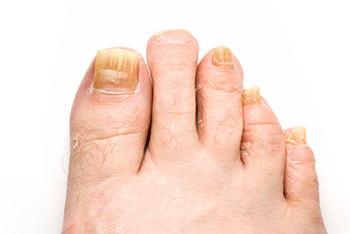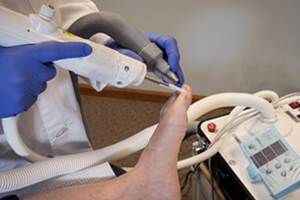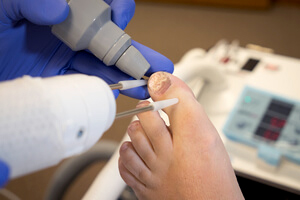Connect With Us
Fungus Toenails
 Toenail fungus is a condition that many people develop and suffer from. Toenail fungus often results in the discoloration and thickening of the toenail, which can cause embarrassment for many people. The condition begins as a small white or yellow growth beneath the tip of the nail and at its worse can develop into the nail’s deterioration.
Toenail fungus is a condition that many people develop and suffer from. Toenail fungus often results in the discoloration and thickening of the toenail, which can cause embarrassment for many people. The condition begins as a small white or yellow growth beneath the tip of the nail and at its worse can develop into the nail’s deterioration.
Thick, ragged, and distorted nails lacking shine are a sign of toenail fungus. The color of the affected nail tends to be darker because of debris buildup underneath the nail. Toenail fungus is more likely to develop for people who wear socks and shoes that do not allow decent ventilation of the feet. Public showers, gyms, and swimming pools are breeding grounds for toenail fungus, as their damp and humid environments allow for the growth of bacteria.
Patients should visit their local podiatrist if they suspect they have toenail fungus because in its more severe stages, toenail fungus can become very painful. Other infections can develop from toenail fungus that can spread to other parts of the body. Upon examination for fungus, your podiatrist may scrape your nails if he or she finds debris. This will be sent to a lab to determine what fungus is causing the condition.
Toenail fungus can also be treated with certain over-the-counter antifungal creams and ointments. To remove pressure from the nails, keep them cut at a short length. Oral antifungal drugs, medicated nail cream, or medicated nail polish may also be prescribed by your podiatrist if simpler treatments do not prove successful. In some cases, your podiatrist may also recommend laser treatment to eradicate toenail fungus.
Laser Treatment for Fungal Toenails
Serving Amherst, North Tonawanda, Lewiston, NY & Beyond


Do I need to treat the infection? No. Some patients choose to live with the infection and manage the condition by periodic debridement (trimming and reducing the thickness of the toenail) for comfort.
What treatment options are available for fungus toenails?
- Oral antifungals approved for the treatment of onychomycosis include; Lamisil (terbinafine), Sporanox (itraconazole) and Griseofulvin. Diflucan (fluconazole) is also occasionally prescribed particularly when yeast is felt to be the culprit. Although the oral medications often provide reasonably good success rates (approximately 70% for terbinafine)) they must be prescribed and monitored carefully. These medications require periodic blood tests to monitor liver function and can have various side effects (taste disturbances, alterations in blood counts) and also carry the possibility of drug – drug interactions.
- Topical prescription antifungals such as Penlac 8% (ciclopirox) lacquer, Jublia 10% (efinaconazole) topical solution and Kerydin 5% (tavarabole) topical solution can be helpful however the success rates will vary with the type of fungus and the degree of involvement. Most of the topical products are effective only in mild to moderate cases. The thicker the toenail, the less likely the topical products will be able to reach the site of infection. Ie: Penlac has been reported to penetrate 0.4mm through the diseased nail. Unfortunately, some fungus toenails can reach up to 8mm in thickness . There are also a myriad of home remedies and over the counter medications being promoted for treatment.
When comparing success rates of any of these products it is useful to compare how the results are compiled.
A mycological cure = the presence of a negative fungal culture and KOH test only while the toenail could still look discolored
A complete cure = mycological cure + a normal appearing toenail
The literature states the following results when comparing efinaconazole and tavarabole, the two newest topical agents used once daily for 48 weeks. A complete cure was achieved in (6.5 - 9.1%) of patients using Tavarabole and (15.2-17.8%) percent of patients using Efinaconazole. - Permanent surgical removal of the toenail. This method can offer patients an avenue for pain relief as well as cosmetic cure however does involve a period of disability and is not always 100% effective.
- Laser treatment - the available literature reports cure rates of 77-90%
How does the laser work?
Lasers work by penetrating through the thickened, diseased toenail into the nail bed to create a coagulation effect by superheating the tissues. This process cleaves the fungal cell wall and effectively results in destruction of the fungus. One must wait for the nail to grow out (usually 4-6 months) before the disease free nail becomes evident. The laser has no adverse effects on normal surrounding skin.
What makes the Aerolase Nd:YAG 1064 nm laser different from other lasers on the market?
There are many FDA approved 1064 Nd:YAG lasers on the market for treatment of fungus toenails however the energy (Fluence) which they generate to penetrate the nail varies significantly. If a laser does not have enough power (fluence) to penetrate through the diseased nail, the effects will only be seen at the upper most surface and will not reach the deeper more active site of infection. The Aerolase laser has developed a technology whereby it can generate a fluence (up to 1274 Joules/cm2) versus many of its competitors who are only able to achieve a fluence of 600 Joules/cm2. Aerolase laser uses a very short pulse width duration of 0.65 micro second. Success rates are reported to be between 77-90%.
Is the Aerolase laser treatment painful?
Some patients can experience mild discomfort however at Lockport Foot Care, we use a special skin cooling device to continuously cool the area during treatment to make the treatment virtually painfree. This allows a patient to receive the highest energy treatment available which translates into the highest success rates in the industry.
Is there any disability or complications associated with the procedure?
Countless studies have shown that there are no post treatment side effects from this treatment. You can resume normal activities immediately following the procedure.
How long does the laser procedure take to perform?
Depending on the number of toenails being treated, treatment can take anywhere between 5 minutes for one toenail to 30 minutes for all ten toenails. The toenails are often trimmed prior to treatment if they are excessively thickened.
Are safety goggles required during treatment?
Safety is important to us. Laser light beams are not visible to the eye and can potentially cause damage to the retina. Therefore all people in the treatment room are provided with special laser eyewear that are designed to specifically block the dangerous wavelengths of light that can affect the eye.
Can the infection recur?
There is always a chance of reinfection if exposed to a new fungal source. Important information is provided following treatment to help prevent reinfection. SteriShoe ultra violet shoe sanitizers can be helpful to kill bacteria and fungus in your everyday shoes. Other common sense precautions can be helpful.
Can diabetics receive treatment?
Many diabetics can be at risk of vascular disease or nerve disease called peripheral neuropathy. Infections in and around the toes and toenails can become limb threatening problems in the aging diabetic. If the physical examination of an individual with diabetes demonstrates the appropriate parameters for healing, a diabetic may undergo this treatment.
What preparation needs to be taken prior to receiving treatment?
Toenails will need to be free of any nail polish prior to receiving treatment. This will need to be performed the day prior to the treatment.
Can the toenails be polished following treatment?
Yes nail polish can be applied immediately following treatment if desired.
Is the laser treatment covered by major insurances?
Unfortunately, this treatment is considered cosmetic and is not covered by insurance companies.
How much does the laser treatment cost?
- The cost will vary depending on the number of toenails being treated. Please refer to our pricing schedule available in the office. All follow up visits (excludes treatment) are included in the pricing package for a period of one year from the date of the first laser treatment. Lockport Foot Care’s prices are very competitive and significantly lower than the national average. Payment options include cash, check, Master Card, Visa, Discover, debit card or Care Credit. In some instances, health savings accounts, or flexible spending accounts may also allow coverage.
